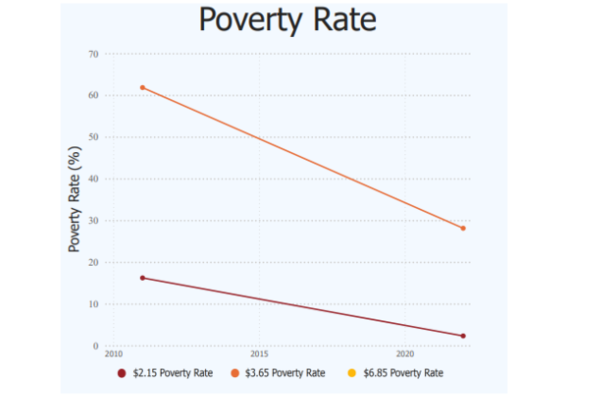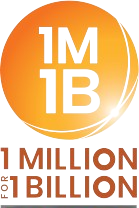NEW DELHI: India has successfully lifted 171 million people out of extreme poverty in the decade spanning from 2011-12 to 2022-23, according to the World Bank‘s latest “Poverty & Equity Brief.”
The report reveals that extreme poverty, defined as living on less than USD 2.15 per day, fell from 16.2% in 2011-12 to 2.3% in 2022-23. This significant reduction marks the country’s success in pulling 171 million people above the extreme poverty line.
“Over the past decade, India has significantly reduced poverty. Extreme poverty (living on less than $2.15 per day) fell from 16.2 percent in 2011-12 to 2.3 percent in 2022-23, lifting 171 million people above this line. Rural extreme poverty dropped from 18.4 percent to 2.8 percent, and urban from 10.7 percent to 1.1 percent, narrowing the rural-urban gap from 7.7 to 1.7 percentage points—a 16 percent annual decline.” the World Bank report stated.
“India also transitioned into the lower-middle-income category. Using the $3.65 per day LMIC poverty line, poverty fell from 61.8 percent to 28.1 percent, lifting 378 million people out of poverty. Rural poverty dropped from 69 percent to 32.5 percent, and urban poverty from 43.5 percent to 17.2 percent, reducing the rural-urban gap from 25 to 15 percentage points with a 7 percent annual decline.” The report added.

Source -World Bank
The World Bank also noted that rural extreme poverty decreased from 18.4% to 2.8%, and urban extreme poverty dropped from 10.7% to 1.1%. The gap between rural and urban poverty narrowed from 7.7 to 1.7 percentage points, reflecting an annual decline of 16%.
Poverty levels in India at different poverty lines for 2022
In its assessment, the World Bank further observed that India transitioned into the lower-middle-income category. Using the USD 3.65 per day poverty line for lower-middle-income countries (LMIC), overall poverty fell from 61.8% to 28.1%, lifting 378 million people out of poverty. Rural poverty dropped from 69% to 32.5%, and urban poverty from 43.5% to 17.2%, reducing the rural-urban gap from 25 to 15 percentage points, with a 7% annual decline.
The brief also highlighted that India’s five most populous states—Uttar Pradesh, Maharashtra, Bihar, West Bengal, and Madhya Pradesh—accounted for 65% of the country’s extreme poor in 2011-12. These states were responsible for two-thirds of the reduction in extreme poverty by 2022-23. However, by 2022-23, these states still accounted for 54% of India’s extremely poor and 51% of its multidimensionally poor population.
The World Bank’s multidimensional poverty index (MPI), which measures non-monetary poverty, showed a decline from 53.8% in 2005-06 to 16.4% by 2019-21.
Regarding employment, the World Bank noted that employment growth had outpaced the working-age population since 2021-22, with employment rates, particularly among women, rising. Urban unemployment fell to 6.6% in Q1 FY24/25, the lowest since 2017-18. The data also indicated a shift of male workers from rural to urban areas for the first time since 2018-19, while rural female employment in agriculture has increased.
Despite these improvements, challenges persist. The report highlighted that youth unemployment stands at 13.3%, with the rate rising to 29% among tertiary education graduates. Only 23% of non-farm paid jobs are formal, and much of agricultural employment remains informal. Furthermore, while self-employment is on the rise, especially among rural workers and women, gender disparities persist, with 234 million more men in paid work than women.
The World Bank’s Poverty and Equity Briefs provide valuable insights into poverty, shared prosperity, and inequality trends across over 100 developing countries. These briefs are released twice a year and serve as a key resource for understanding poverty reduction efforts globally




